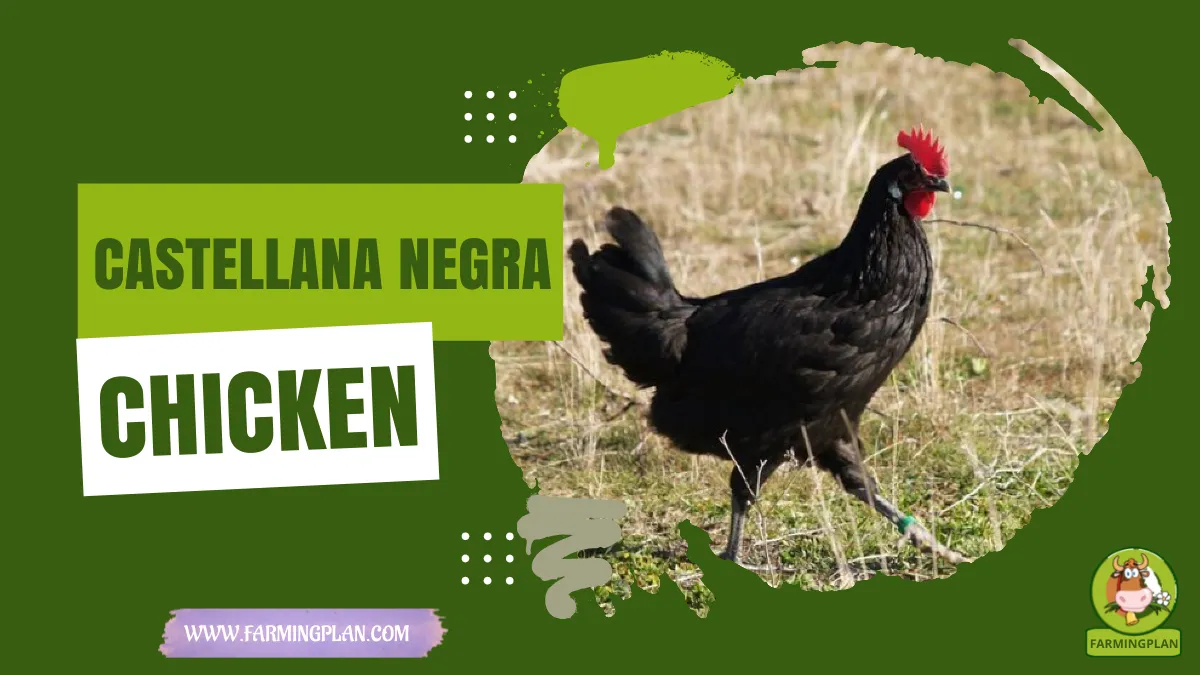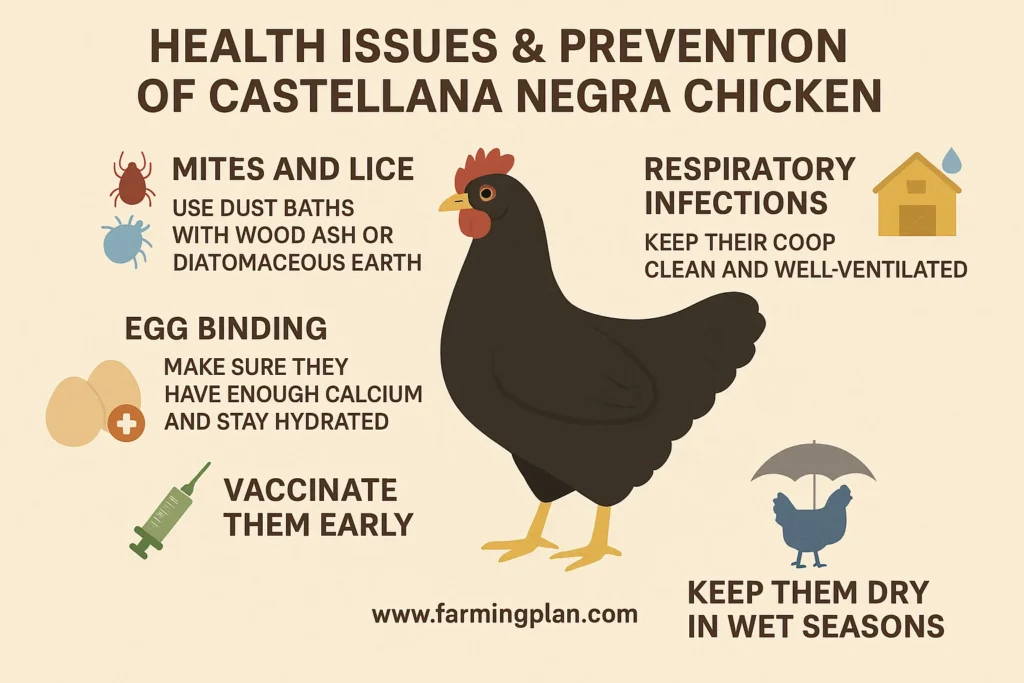Let me introduce you to one of my all-time favorite birds—the Castellana Negra Chicken. This native Spanish breed isn’t just stunning with its jet-black plumage—it’s also one of the toughest and most dependable chickens I’ve ever worked with. I remember the first time I saw a Castellana Negra; it was like love at first sight. Whether you’re a farmer looking to expand your flock, a breeder chasing rare beauty, or a pet owner seeking something unique, the Castellana Negra ticks every box. So, if you’ve ever wondered whether the Castellana Negra Chicken is right for you, you’re in the right place.

History & Origin of Castellana Negra Chicken
The Castellana Negra is one of the oldest and most iconic Spanish chicken breeds. Known in Spain as Gallina Castellana Negra or simply Raza Castellana, this breed originated in the central and western regions of the Iberian Peninsula, particularly Castilla. Back in the 19th century, it was a favorite for both its egg-laying ability and adaptability to Spain’s hot, dry climates.

It was so reliable that even Spanish farmers with minimal resources could depend on it. Interestingly, some sources suggest that these birds may have been part of the bloodline that made its way into Mexican chicken breeds, including the hardy Huastec Chicken. The breed nearly disappeared during the 20th century due to industrial farming’s focus on hybrid layers, but conservationists brought it back from the edge. Today, it’s protected under various Spanish heritage breed programs and recognized for its cultural importance.
Read More: Shetland Sheep: Colorful, Hardy & Full of Charm
Characteristics
These birds have some seriously striking features. The Castellana Negra is a medium-sized bird with sleek, glossy black plumage that almost shimmers in the sunlight. The feathers are tight and neat, giving them a polished look. Males are a little larger and have long tail feathers that arc beautifully.
They have a bright red single comb that stands tall on both males and females, adding a bold contrast to their dark feathers. Their white earlobes stand out sharply against the black body—a sure sign of a Mediterranean egg layer. This breed is often compared to the Andalusian chicken for its elegance but is more rugged in my experience. No fancy frills—just hard-working, hardy birds built for both form and function.
Nature & Temperament
When folks ask me about the Castellana Negra chicken temperament, I always say the same thing—bold but independent. These birds are super active and alert. They’re not the cuddly type, but they’re great foragers and rarely cause trouble. They’re a bit standoffish with people at first, but with regular handling, they warm up. I wouldn’t recommend them for very young kids unless you’re okay with a more hands-off pet chicken.
But for farmers, homesteaders, or hobbyists looking for a no-nonsense bird that gets the job done, these are a dream. They don’t bully other chickens, but they do like their space. If you’re mixing breeds, give them some room to roam. Their energy and smarts make them excellent free-rangers, too.
Food & Diet of Castellana Negra Chicken
Feeding the Castellana Negra Chicken is straightforward, but a good diet makes all the difference in egg production and health. I stick to high-protein layer feed (16–18%) during the laying season. That keeps their production up and feathers glossy. These birds are fantastic foragers, so if you can let them free-range, they’ll munch on weeds, bugs, and even small reptiles.

I supplement with occasional grains, crushed oyster shells for calcium, and plenty of clean water. Avoid giving them anything salty, sugary, or spoiled. No avocado, no raw beans. I always say: “If you wouldn’t eat it, your chicken probably shouldn’t either.”
Usage & Purpose
The Castellana Negra Chicken is primarily a layer, producing around 180–200 medium to large white eggs per year. Their egg quality is excellent, with firm whites and strong shells. These birds aren’t usually raised for meat, but I’ve seen some folks use older hens or extra roosters for small-batch cooking.
They’re also popular in poultry shows thanks to their exotic appearance. In Spain and parts of Mexico, they’re sometimes featured in local exhibitions as a symbol of heritage breeds. Whether you want them for farming, shows, or to admire in your backyard, they do a little bit of everything. Their high egg production, excellent egg quality, and unique appearance make them a great choice for various purposes.
Special Features
One thing I love about the Castellana Negra is how tough they are. These birds are disease-resistant, heat-tolerant, and handle dry climates like pros. That’s a big reason they’ve been a go-to breed in southern Spain and Mexico.
Some unique traits include:
- Jet-black plumage: that resists dirt and keeps them looking clean
- Mediterranean-type body: slim, agile, and built for foraging
- Long lifespan: I’ve had hens lay eggs into their sixth year
- Genetic purity: recognized as one of Spain’s most authentic native breeds
If you want a heritage bird that can handle rough conditions and still look amazing, this is the one.
Read More: Burlina Cattle: Legendary Dairy Breed With Exceptional Milk
Health Issues & Prevention of Castellana Negra Chicken
I’ve found Castellana Negra Chickens to be one of the healthiest breeds around. Still, like all chickens, they’re not invincible. Common issues include:

- Mites and lice: Use dust baths with wood ash or diatomaceous earth.
- Respiratory infections: Keep their coop clean and well-ventilated.
- Egg binding: Make sure they have enough calcium and stay hydrated.
Vaccinate them early and keep them dry in wet seasons. I clean the coop weekly and use natural herbal sprays to discourage pests. Healthy chickens are happy chickens—and these birds reward good care with plenty of eggs.
“Raise A Chicken That’s Tough As Nails And Looks Like Royalty—The Castellana Negra Is Beauty With A Backbone!”
Step-by-Step Farming Guide for Castellana Negra Chicken
Step 1: Choose Healthy Stock or Hatching Eggs
Start by finding reputable breeders who offer Castellana Negra chickens for sale. I prefer getting fertilized eggs to hatch in an incubator, but live chicks are fine, too. Look for strong legs, alert eyes, and smooth feathers. Once your chicks arrive, please give them a warm brooder (95°F for the first week), clean bedding, and chick starter feed.
Step 2: Set Up the Ideal Coop
These birds need space and airflow. My coop setup includes:
- 4 square feet per bird
- Roosts 2–3 feet off the ground
- Easy access to nesting boxes
Keep the coop clean and dry to prevent respiratory issues.
Step 3: Daily Care Routine
Every morning, I check food and water. I open the run or let them out to free range. In the evening, I gather eggs, do a quick health check, and lock them up tight. Keep an eye on weight, activity, and feather condition. Happy birds = healthy eggs.
Step 4: Seasonal Considerations
In summer, offer shade and cool water. In winter, use deep litter and seal drafts, but allow for some ventilation. Molting season is a good time to boost protein in their diet to help with feather regrowth.
Step 5: Breeding & Record Keeping
If you plan to breed, select birds with strong genetics and correct color traits. I always keep a notebook to track egg production, hatch rates, and health events. This helps improve your flock year after year.
Expert Tips & Best Practices
- Let Them Free-Range – They forage like champs and stay healthier.
- Add Herbs to Feed – Garlic, oregano, and thyme support immunity.
- Use Sand in the Coop – Easier to clean, and the birds love dust bathing.
- Keep Nesting Boxes Dark and Cozy – Encourages better egg laying.
- Rotate Feeders and Waterers – Prevents boredom and keeps them active.
FAQs
Are Castellana Negra chickens good egg layers?
Yes! They lay about 180–200 white eggs per year and are consistent producers.
Where can I find Castellana Negra chickens for sale?
Check Spanish poultry breeders or specialty hatcheries online that carry heritage breeds.
Are they good for beginners?
Yes, but they’re best for those with a bit of space and some chicken experience—they’re independent and active.
What color eggs do Castellana Negra chickens lay?
They lay white eggs with hard shells and excellent yolk quality.
Can I keep them with other chicken breeds?
Absolutely. Just make sure they have enough room to roam, as they enjoy their personal space.
Conclusion
Raising the Castellana Negra Chicken has been one of the most rewarding experiences on my farm. With their stunning looks, excellent egg production, and strong heritage roots, they offer the perfect balance of function and beauty. Whether you’re breeding for quality, farming for eggs, or want a unique backyard bird, this Spanish gem won’t disappoint. So why not add a little bold beauty to your flock? Dive into the world of native breeds and help preserve a piece of poultry history—your coop (and breakfast table) will thank you!

